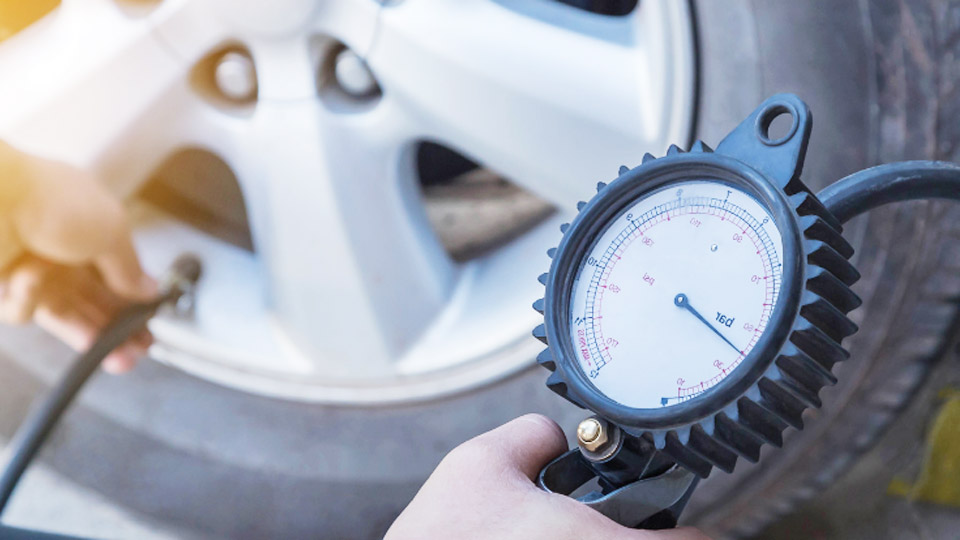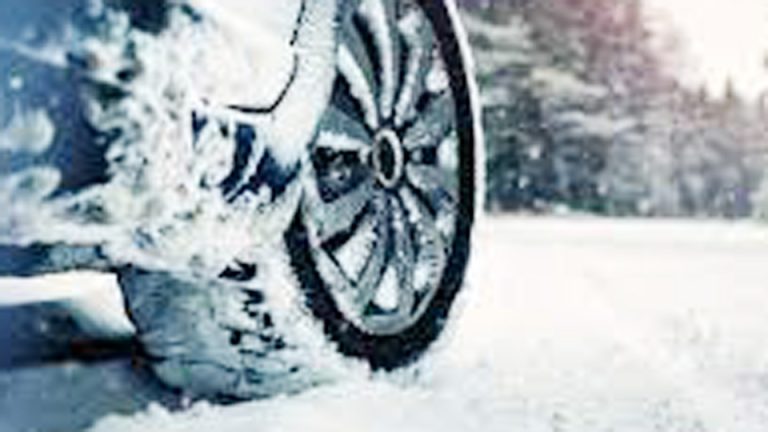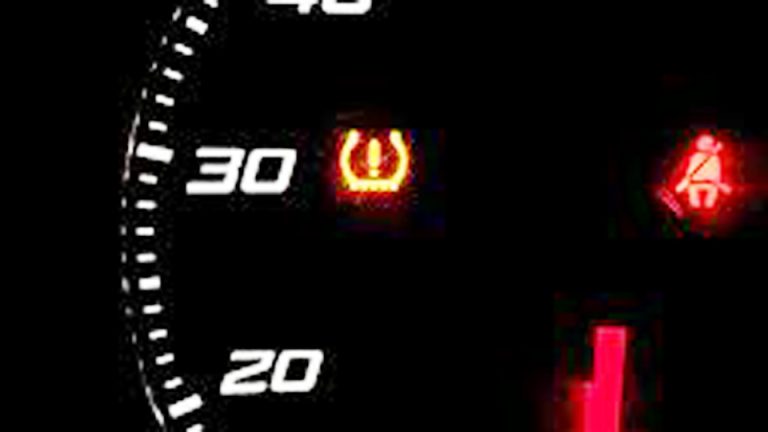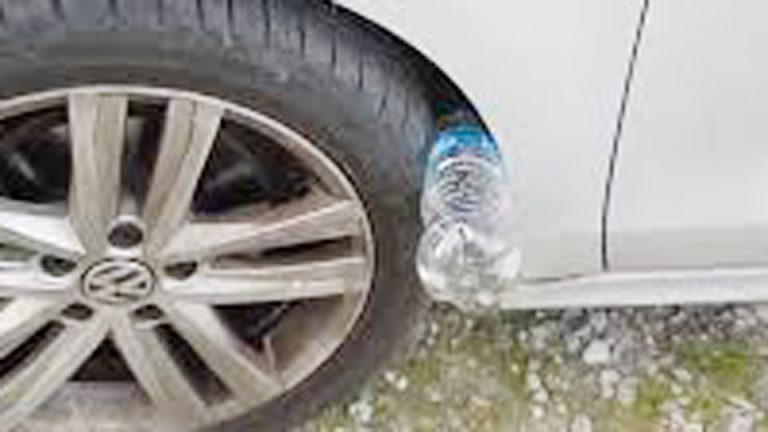You’re in your driveway, ready to check the tires on your car—maybe a trusty Honda Accord like mine or a rugged Ford F-150—and you notice those green valve caps, a sign your tires are filled with nitrogen.
You might be wondering, “How do I check nitrogen tire pressure, and is it any different from checking regular air?” As someone who’s spent years tinkering with cars, from my Jeep Wrangler to my neighbor’s Toyota Camry, I’ve checked nitrogen-filled tires plenty of times and learned the ins and outs.
Nitrogen tires have some unique quirks, but checking them is straightforward once you know the ropes. I’ll walk you through the process step-by-step, share real-world stories from my garage, and give you tips to keep your tires in top shape.
If you’re new to car maintenance or a seasoned gearhead, I’ve got you covered with practical advice. Let’s roll up our sleeves and dive into how to check nitrogen tire pressure!

Image by fuelandtiresaver
Why Nitrogen in Tires?
Before we get into the how-to, let’s talk about why your tires might be filled with nitrogen. Nitrogen is nearly pure—about 93-99%—unlike regular air, which is 78% nitrogen, 21% oxygen, and a mix of other gases with some moisture. Nitrogen leaks slower and stays drier, keeping tire pressure more stable and reducing wheel corrosion.
I switched to nitrogen in my Accord after a tire shop recommended it, and I noticed less pressure loss compared to my air-filled F-150. Checking nitrogen tire pressure is key to maintaining those benefits, so let’s break it down.
Why Checking Nitrogen Tire Pressure Matters
Tire pressure affects handling, fuel economy, tire wear, and safety. Nitrogen-filled tires hold pressure better than air-filled ones, but they still leak over time or with temperature changes. I learned this with my Wrangler—its nitrogen tires stayed steady, but I still checked them monthly to avoid surprises.
Underinflated tires can make your car sluggish or unsafe, while overinflated ones wear out fast. Knowing how to check nitrogen tire pressure keeps your vehicle running smoothly and maximizes nitrogen’s perks.
Tools You’ll Need
Checking nitrogen tire pressure is simple, but you need the right tools. Here’s what I keep in my garage:
- Tire pressure gauge: A digital or analog gauge works. I use a digital one for precision.
- Clean rag or paper towel: To wipe the valve stem.
- Gloves (optional): To keep hands clean.
- Flashlight: To see valve stems in dim light.
- Air compressor or nitrogen source (optional): For topping off if needed.
- Pen and notebook: To track pressure readings.
I learned to use a quality gauge after a cheap one gave me bad readings on my Camry—accuracy matters!
Step-by-Step Guide to Checking Nitrogen Tire Pressure
Here’s how I check nitrogen tire pressure, based on years of working on my cars and trucks:
Step 1: Park on a Flat Surface
Park your car on level ground to get accurate readings. I do this in my driveway with my Accord. Make sure the tires are “cold”—meaning the car hasn’t been driven for at least 3 hours, as driving heats the tires and raises pressure. I once checked my F-150’s tires right after a long drive, and the readings were 5 psi too high.
Step 2: Find the Recommended Pressure
Check your car’s manual or the sticker on the driver’s side door jamb for the recommended tire pressure (usually 30-35 psi for cars, 40-50 psi for trucks). My Accord’s sticker says 32 psi front, 30 psi rear. Write it down so you know what to aim for. Don’t rely on the tire’s sidewall number—that’s the maximum pressure, not the ideal.
Step 3: Locate the Valve Stems
Find the valve stem on each tire—it’s the small metal or rubber piece sticking out, often with a green cap for nitrogen-filled tires. My Camry’s green caps make it easy to spot. Remove the cap and set it aside where it won’t get lost. I dropped one under my Wrangler once and spent 10 minutes searching!
Step 4: Clean the Valve Stem
Wipe the valve stem with a rag to remove dirt or debris. Dirt can mess with the gauge or let air escape. I learned this the hard way when grit on my F-150’s valve stem caused a small leak during a check.
Step 5: Use the Tire Pressure Gauge
Press the gauge firmly onto the valve stem to get a reading. If it hisses, adjust until it seals. I use a digital gauge on my Accord—it’s quick and clear. Note the pressure for each tire. My Wrangler’s nitrogen tires usually read 31-32 psi when cold, close to the recommended 32 psi.
Step 6: Compare to Recommended Pressure
Check if the readings match the recommended pressure. If a tire’s low (say, 28 psi when it should be 32), it needs topping off. If it’s high (like 36 psi), you might need to release some nitrogen. My Camry’s rear tires were once 2 psi low, so I headed to a shop for a nitrogen refill.
Step 7: Repeat for All Tires
Check all four tires (and the spare if it’s nitrogen-filled). I always check my F-150’s spare, especially for towing trips. Write down each reading to track trends over time. I noticed my Wrangler’s front tires lose pressure slightly faster than the rear, so I keep an eye on them.
Step 8: Replace Valve Caps
Screw the valve caps back on tightly to keep dirt out and prevent leaks. I make sure my Accord’s green caps are snug—loose caps can cause slow leaks over time.
Step 9: Top Off if Needed
If a tire’s low, visit a shop with a nitrogen generator to top off. Don’t use regular air—it dilutes nitrogen’s benefits by adding moisture and oxygen. I made this mistake with my Camry once, and the tires lost pressure faster afterward. If a tire’s too high, release a bit of nitrogen with the gauge’s release valve until it’s correct.
Common Issues When Checking Nitrogen Tire Pressure
I’ve run into a few hiccups over the years. Here’s what to watch for:
- Inaccurate Gauges: Cheap gauges can give wrong readings. My first gauge was off by 3 psi on my Ram—invest in a good one.
- Hot Tires: Checking after driving skews results. I got high readings on my F-150 after a highway trip.
- Dirty Valve Stems: Grit can cause leaks. I clean my Wrangler’s stems every time.
- Mixing Air and Nitrogen: Using air to top off reduces nitrogen’s benefits. I learned this with my Camry.
Tools Comparison: Choosing a Tire Pressure Gauge
Here’s a table of gauges I’ve used to check nitrogen tire pressure:
| Gauge Type | Pros | Cons | Cost |
|---|---|---|---|
| Digital Gauge | Accurate, easy to read | Needs batteries, pricier | $10-$30 |
| Analog (Dial) Gauge | Durable, no batteries | Harder to read in low light | $5-$20 |
| Stick Gauge | Cheap, portable | Less accurate, hard to read | $2-$10 |
I use a digital gauge for my Accord and F-150—it’s fast and precise. Stick gauges work for quick checks on my Ram but aren’t as reliable.
Why Nitrogen Requires Special Care
Nitrogen tires need a bit more attention than air-filled ones to maintain their benefits. Since nitrogen is drier and leaks slower, you want to keep it pure. Topping off with air, like I did once with my Camry, adds moisture and oxygen, causing pressure swings and corrosion risks.
Plus, nitrogen isn’t available at gas stations—you need a shop with a nitrogen generator. I learned to plan ahead after struggling to find a nitrogen fill for my Wrangler on a road trip.
How Often to Check Nitrogen Tire Pressure
I check my nitrogen-filled tires every 4-6 weeks, or monthly if I’m towing with my F-150. Nitrogen leaks slower than air, so you don’t need to check as often as air-filled tires (which I check weekly on my Ram). Check more often if:
- You notice handling issues, like pulling or sluggishness.
- You’re driving in extreme heat or cold, which can affect pressure.
- You’re preparing for a long trip or towing, like I do with my F-150.
My Accord’s nitrogen tires rarely drop more than 1-2 psi a month, but I still check to be safe.
Cost of Maintaining Nitrogen Tire Pressure
Checking pressure is free if you have a gauge, but topping off nitrogen costs money. Here’s what I’ve seen:
| Item | Estimated Cost | Notes |
|---|---|---|
| Digital Tire Gauge | $10-$30 | One-time purchase, reusable |
| Nitrogen Top-Off (per tire) | $3-$10 | Varies by shop |
| Nitrogen Initial Fill (per tire) | $5-$20 | Often free with new tires |
| Professional Tire Service | $50-$150 | Includes nitrogen, alignment |
| Air Top-Off | Free-$2 | Gas station pumps |
I spent $15 to top off my Camry’s nitrogen tires last year, but my air-filled Ram costs nothing to maintain at gas stations.
Nitrogen vs Air: Checking Differences
Checking nitrogen tire pressure is similar to checking air-filled tires, but there are key differences:
| Feature | Nitrogen Tires | Air-Filled Tires |
|---|---|---|
| Check Frequency | Every 4-6 weeks | Weekly |
| Top-Off Source | Shop with nitrogen | Gas station or compressor |
| Pressure Stability | Loses 1-2 psi/month | Loses 3-5 psi/month |
| Cost to Top Off | $3-$10 per tire | Free-$2 |
I check my nitrogen-filled Accord less often than my air-filled Ram, but finding a nitrogen fill is trickier.
My Real-World Experience Checking Nitrogen Tire Pressure
Let me share a couple of stories. When I got nitrogen-filled tires on my Honda Accord, I was excited about the stable pressure. I checked them monthly with a digital gauge, and they stayed within 1 psi of 32 psi, even in winter.
But when I got a slow leak on a road trip, I couldn’t find a nitrogen fill in a small town. I topped off with air, and the tires started losing pressure faster, like my air-filled Ram. Lesson learned: stick to nitrogen for top-offs.
On my Ford F-150, I tow a trailer for work, so tire pressure is critical. Checking nitrogen pressure before trips is easy with my digital gauge, and the tires hold steady at 40 psi. My air-filled Wrangler, though, needed weekly checks and frequent top-offs in hot weather. Nitrogen’s less work, but I have to plan for shop visits.
Common Mistakes When Checking Nitrogen Tire Pressure
I’ve made errors over the years. Here’s what to avoid:
- Using Air to Top Off: It dilutes nitrogen’s benefits. I did this on my Camry and regretted it.
- Checking Hot Tires: Always check when tires are cold. My F-150’s hot readings were misleading.
- Using a Cheap Gauge: Inaccurate readings can mess up adjustments. My Ram’s stick gauge was off by 3 psi.
- Ignoring Slow Leaks: Nitrogen won’t fix punctures. My Wrangler needed a patch despite nitrogen.
When to Top Off Nitrogen Tires
If your tires are 2-3 psi below the recommended pressure, top them off at a shop with a nitrogen generator. I do this for my Accord when the rear tires drop to 28 psi (recommended 30 psi).
Don’t overfill—too much pressure causes uneven wear. My F-150’s tires were once at 44 psi when they should’ve been 40, so I released a bit with my gauge’s valve.
Finding a Nitrogen Fill Station
Not every shop offers nitrogen, so plan ahead. I found a local tire shop for my Camry that charges $5 per tire to top off. Dealerships and big chains often have nitrogen generators, and some include it free with tire purchases.
My F-150’s shop uses green caps to mark nitrogen tires, making it easy to confirm. If you’re on the road, call ahead to find a nitrogen fill—my Wrangler’s road trip taught me that.
Nitrogen Tires in Different Vehicles
Here’s how checking nitrogen pressure worked for my vehicles:
| Vehicle | Nitrogen Experience | Notes |
|---|---|---|
| Honda Accord (2016) | Easy checks, stable pressure | Great for daily driving |
| Ford F-150 (2018) | Steady for towing, shop refills | Ideal for heavy loads |
| Jeep Wrangler (2012) | Consistent in heat, hard to top off | Good for off-roading |
| Dodge Ram (2005) | Air-filled, frequent checks | Budget-friendly option |
Nitrogen was easiest for my Accord and F-150, but my air-filled Ram was simpler to top off.
What Not to Do When Checking Nitrogen Tire Pressure
Here’s what I’ve learned to avoid:
- Don’t Use Air Pumps: They reduce nitrogen’s benefits. I messed this up with my Camry.
- Don’t Skip Checks: Monthly checks catch issues early, even with nitrogen.
- Don’t Overfill: Too much pressure wears tires unevenly. I adjusted my F-150’s tires to avoid this.
- Don’t Ignore Damage: Nitrogen doesn’t fix punctures. My Wrangler needed repairs.
Practical Tips for Checking Nitrogen Tire Pressure
Here are my tips to make it easy:
- Get a Digital Gauge: It’s accurate and easy to read. I use one for all my cars.
- Check When Cold: Wait 3 hours after driving for true readings.
- Track Readings: Write down pressure to spot trends. I do this for my F-150.
- Find a Reliable Shop: Ensure nitrogen refills are nearby. I confirmed this for my Accord.
These tricks save time and keep your tires in check.
Wrapping It Up
So, how do you check nitrogen tire pressure? From my experience with my Accord, F-150, and more, it’s a simple process—grab a good gauge, check cold tires, and top off with nitrogen at a shop if needed.
It’s no different from checking air-filled tires, but you’ve got to be careful to maintain nitrogen’s purity to keep its benefits, like stable pressure and less corrosion. Regular checks ensure better handling, fuel economy, and tire life, whether you’re commuting or towing.
Stay on top of your tire pressure, use the right tools, and plan for nitrogen refills. Here’s to safe drives and tires that keep you rolling smoothly!
Frequently Asked Questions
How do you check nitrogen tire pressure?
Use a tire pressure gauge on cold tires, compare to the recommended psi on your car’s door jamb, and top off with nitrogen if needed.
Is checking nitrogen tire pressure different from air?
It’s the same process, but you top off with nitrogen at a shop, not air, to maintain benefits. I check my Accord’s nitrogen tires monthly.
How often should I check nitrogen tire pressure?
Every 4-6 weeks, or monthly for heavy use like towing. I check my F-150’s tires before trips.
What happens if I top off nitrogen tires with air?
It adds moisture and oxygen, reducing nitrogen’s benefits like stable pressure. I did this with my Camry and saw more pressure loss.
Where can I top off nitrogen tire pressure?
At tire shops or dealerships with nitrogen generators. I use a local shop for my Accord, charging $5 per tire.




